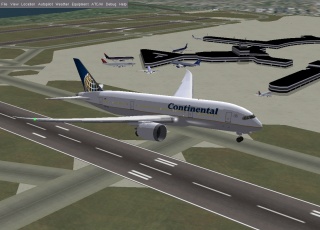FlightGear
| FlightGear | |
|---|---|
 FlightGear | |
| Genre | Flight simulator |
| Latest release | 2024.1.1 (Announcement) |
| Release date | February 27th, 2025 |
| Platforms | GNU/Linux, FreeBSD, Windows, macOS |
| Developer | Wolfram Kuss, Vassilii Khachaturov, Norman Vine, Jon S. Berndt, Cameron Moore,Durk Talsma, Curtis Olson, Bernie Bright, Tony Peden, and Alex Perry |
| Code license | GPL |
| Media license | GPL |
| Engine | OpenSceneGraph |
| P. language | C++, C |
| Library | PLIB |
| Homepage | http://www.flightgear.org/ |
| Contribute | |
| FlightGear is a free game. This means that the source code is available to be studied, modified, and distributed. Most projects look for help with testing, documentation, graphics, etc., as well. | |
| flightgear | |
| flightgear | |
| FlightGear | |
| org.flightgear.FlightGear | |
| flightgear | |
| games-simulation/flightgear | |
| FlightGear | |
| flightgear | |
| FlightGear | |
| flightgear |
FlightGear is a 3D flight simulation game. The entire game is licensed under the GNU General Public License.[1][2] It is also sold on 3 DVDs. It is written in the C++ [3] and C [4] programming languages.
The project was started in 1996, with its first release in 1997.
Development[edit]
FlightGear used a simulation engine called SimGear in addition to a terrain engine called TerraGear. All of which needs PLIB in order to build.[5][6]
Developers[edit]
The development team consists of ten members.[7]
They are:
- Alex Perry
- Tony Peden
- Bernie Bright
- Curtis Olson
- Durk Talsma
- Cameron Moore
- Jon S. Berndt
- Norman Vine
- Vassilii Khachaturov
- Wolfram Kuss
History[edit]
Development started in 1996. The first release happened on July 17th, 1997. Rather than developing their own simulation models, they opted to NASA's flight models instead. They transitioned out of beta in 2008.[8] See FlightGear release history for more details.
Distribution[edit]
Binary executables are downloadable for Windows and Mac from sourceforge. Binaries for Linux are also available from FlightGear version 2020.3+ [9]
A stripped down version of Flightgear is also available on Raspberry Pi [10].
People on Linux can also download and build FlightGear from the PPA repositories for their distribution [11]. It is recommended to download the larger "data" package containing art and content from sourceforge if transfers are slow.
700+ aircraft in the official Hangar can be downloaded with 1 click from the launcher [12], other aircraft have to be downloaded from 3rd party hangars [13] or from repositories on sites like Sourceforge, GitHub, or GitLab.
Scenery is downloaded as you fly when Terrasync is enabled [14].
The FlightGear project sells USB thumb drives/CDs/DVDs on their website. These contain a snapshot of the current state of Scenery, and the current state of Aircraft in the official project repository. They are useful for people with limited internet. [15]
OSM2City roads, buildings, and objects based on Open Street Map data are available as separate downloads, in addition to custom scenery. [16]
External links[edit]
References[edit]
- ↑ FlightGear's copyright file at Debian Packages
- ↑ FlightGear-data copyright file at Debian Packages
- ↑ FlightGear sourceforge.net project page
- ↑ Flightgear FAQ
- ↑ SimGear page on FlightGear wiki accessed on September 13th, 2009
- ↑ TearGear page on FlightGear wiki accessed on September 14th, 2009
- ↑ Sourceforge.net members list for the FlightGear project
- ↑ FlightGear wiki page on FlightGear itself accessed on September 11th, 2009.
- ↑ Flightgear downloads
- ↑ Flightgear on Raspberry Pi
- ↑ FlightGear on Linux
- ↑ Flightgear Launcher
- ↑ Flightgear hangars
- ↑ TerraSync
- ↑ FlightGear store
- ↑ Scenery downloads